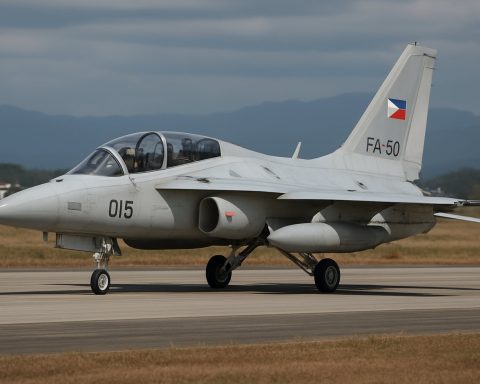- The F-47 is a key breakthrough under the U.S. Air Force’s NGAD program, representing a major leap forward in military technology.
- Developed by Boeing, the F-47 aims to ensure U.S. aerial supremacy through advanced maneuverability and speed.
- The aircraft’s development resumed with political changes, highlighting strategic priorities amid global tensions.
- The estimated cost of each F-47 is around $300 million, underscoring its ambitious capabilities compared to legacy systems like the F-22.
- Geopolitical competition intensifies with China’s advancement of the J-36, prompting U.S. strategic responses.
- Beyond the F-47, the NGAD includes the Collaborative Combat Aircraft (CCA), fostering manned-unmanned tactical integration.
- The F-47 exemplifies the evolution and preparedness of U.S. air combat strategy, marrying technological innovation with strategic foresight.
Sixth-generation fighter jets maneuver through the invisible corridors of futuristic warfare, where air superiority is no longer simply an advantage but a necessity. Amid the rhythmic hum of engine toil and strategic moorings lies the U.S. Air Force’s latest marvel: the F-47. Crafted under the umbrella of the Next-Generation Air Dominance (NGAD) program, this aircraft marks a bold push into uncharted territories of military might and technological prowess.
The stage was set in a wave of political transitions. As the Trump administration returned to the helm, the previously halted NGAD contract sprang to life, awarding Boeing the mission to forge the F-47. This fighter isn’t merely an increment in military evolution; it’s a paradigm shift anticipated to challenge the boundaries of aerial combat.
Designed to outmaneuver and outpace, the F-47 possesses a silhouette that whispers lethal agility. With its inception, America’s commitment to uphold its aerial supremacy stretches far and wide, echoing through corridors of power across the globe. At a time when global conflicts inch closer with a volatile cadence, this fighter emerges as a symbolic sentinel over the skies, ever-vigil over potential threats.
Amid swirling speculation and restricted figureheads, the costs remain shrouded, guarded by a palisade of national security concerns. Nonetheless, the figure floated in 2018—$300 million per airframe—offers a glimpse into the scope and ambition underlying this enterprise. It dwarfs existing systems, casting the F-22, a stalwart of previous generations, into its considerable shadow.
This announcement didn’t exist in a vacuum; it comes against a backdrop of geopolitical tensions, with China pacing in parallel strides toward its own sixth-generation achievement: the elusive J-36. The global stage has become a Chinese whisper of guarded secrets and unveiled prowess. What’s known is scant, but U.S. analysts caution a grounded response to the emerging juggernaut across the Pacific.
Yet, the key narrative is not of competition but of preparedness. As General David Allvin, Air Force Chief of Staff, articulates the joining dots, he envisions the F-47 not merely as a tool of force but a cornerstone in the architectural landscape of strategic readiness.
While the F-47 takes center stage, its advanced companion, the Collaborative Combat Aircraft (CCA), sketches an interconnected future of manned and unmanned synergy. This cadre of autonomous “loyal wingmen” promises an expanded arsenal poised to amplify manned missions, orchestrating a symphony of cohesive operations.
The NGAD’s emergence lights a beacon—it signals a future where multifaceted strategies marry technology’s cutting edges to navigate adversities defined by range, payload, and survivability. It’s a future managed by a compendium of strategies conceived for skirmishes not yet realized but anticipated with unwavering resolve.
Ultimately, the propelling thrust of the F-47 is a statement: America, amid its political pendulum, remains a steadfast vanguard in aeronautical ingenuity. The F-47 is more than metal and circuits; it’s a testament—a silent prodigy of invisible strength cemented by determination and foresight—a poignant reminder of how the art of war evolves, unwavering and relentless in securing the skies.
Unveiling the F-47: The Next Frontier of Air Combat
Introduction
The introduction of sixth-generation fighter jets like the F-47 signifies a revolutionary leap in military technology, especially under the Next-Generation Air Dominance (NGAD) program. While the source article provides a promising glimpse into the future of combat aviation, several aspects warrant further exploration to understand the full potential and implications of this development.
Features, Specs & Pricing
1. Advanced Technologies: The F-47 integrates cutting-edge technologies, including artificial intelligence (AI)-driven systems, stealth capabilities, and enhanced avionics. These features enable the aircraft to operate effectively in contested airspaces and execute complex missions autonomously or in coordination with human pilots.
2. Cost Considerations: While the exact costs are classified, the reported $300 million per airframe places the F-47 among the most expensive military aircraft. This figure reflects its sophisticated features and the investment in future-proofing air combat capabilities.
3. Stealth and Survivability: The F-47 employs advanced stealth technology, allowing it to evade enemy radar and reduce its heat signature. This ensures greater survivability in hostile environments, a crucial factor in modern warfare.
Geopolitical Context and Market Dynamics
1. China’s J-36: The concurrent development of China’s J-36 underscores the ongoing competition for air superiority. Both nations are pushing technological boundaries, leading to a new arms race focused on air dominance.
2. Global Trends: The demand for advanced fighter jets is set to grow as nations seek to bolster their defenses amid rising geopolitical tensions. The market for such aircraft will likely expand, with countries seeking partnerships and technology transfers.
Integration of Manned and Unmanned Systems
1. Collaborative Combat Aircraft (CCA): The introduction of unmanned aerial vehicles as “loyal wingmen” enhances the F-47’s operational capabilities. These drones can perform reconnaissance, electronic warfare, and even direct attacks, thereby reducing risk to human pilots.
2. Strategic Synergy: The combination of manned and unmanned aircraft optimizes strategic operations, ensuring flexibility and adaptability in various combat scenarios.
Technology/Ethical Considerations
1. AI in Combat: The use of AI in fighter jets raises ethical questions about autonomous decision-making in warfare. The military must address concerns about accountability and the potential for unintended consequences.
2. Security and Cyber Threats: With increased digital integration comes the risk of cyberattacks. Ensuring robust cybersecurity measures is critical to protect sensitive systems and maintain operational integrity.
Future Predictions and Recommendations
1. Continuous Innovation: To maintain its edge, the U.S. must continually innovate, investing in R&D and exploring new technologies like quantum computing and hypersonics.
2. International Collaborations: Forming international defense partnerships can enhance technological exchange and improve collective security frameworks.
Conclusion: Actionable Insights
For readers eager to engage with these developments, staying informed through credible defense news sources is vital. Professionals in related industries should focus on advancing skills in AI, data analysis, and cybersecurity to remain relevant as these technologies evolve.
For more information on emerging technologies in defense, visit Lockheed Martin or Northrop Grumman.
Quick Tip: Explore online courses on AI and cybersecurity to better understand the technologies shaping the future of air combat.







